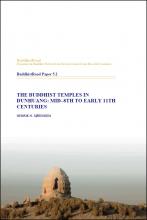BuddhistRoadPaper 5.2 “The Buddhist Temples in Dunhuang: Mid–8th to Early 11th Centuries"
Synopsis
This presentation is a guide to the Buddhist temples and hermitages that existed in Dunhuang during the periods of the Tibetan and Guiyijun rule (851–1036?, 歸義軍, Return-to-Allegiance Army), and covers a timespan of roughly two hundred and fifty years, from the late 8th to mid-11th centuries. I provide as much primary data as possible on local Buddhist institutions, organised for easy reference. There is an entry for each temple that features a historical overview, monastic sustenance, including landholdings, buildings, libraries, scriptures, practices and rituals, important clerics, connections to the construction of caves at Mogao, and notes on location when available. Since previous presentations and documentation of Dunhuang’s temples and their activities in secondary literature are partial, fragmentary, and scattered, this is an attempt to bring together as much data as possible, in order to provide scholars with up-to-date access to the most important material. However, given the vast number of primary sources, not all of the relevant information is included here. Nonetheless, this is an easy-to-use tool to enable further studies.
Chinese Translation
本文介绍了在吐蕃和归义军统治时期 (851–1036?) 敦煌存在的佛教寺庙和隐修地, 涵盖了从8世纪后半叶到11世纪中叶大约250年的时间. 笔者尽可能多的介绍并整理了当地佛教机构的主要数据以方便参考. 每座寺庙都有一个条目, 概述其历史, 介绍寺院概况, 包括土地所有权, 建筑, 藏经阁, 经文, 实修和仪轨, 重要的神职人员, 与开凿莫高窟的关联, 以及部分寺院的地理位置. 由于以前涉及敦煌寺庙及其活动的介绍和文献的二手资料多是片面, 零碎和分散的, 本文试图汇集尽可能多的信息, 以便为进一步研究提供最新且最重要的资料. 不过, 鉴于基础资料的数量庞大, 本文并没有将所有相关信息都囊括其中. 即便如此, 本文仍是一个易于使用的有助于进一步研究的工具.

Downloads
Published
Categories
License

This work is licensed under a Creative Commons Attribution-NonCommercial-NoDerivatives 4.0 International License.

